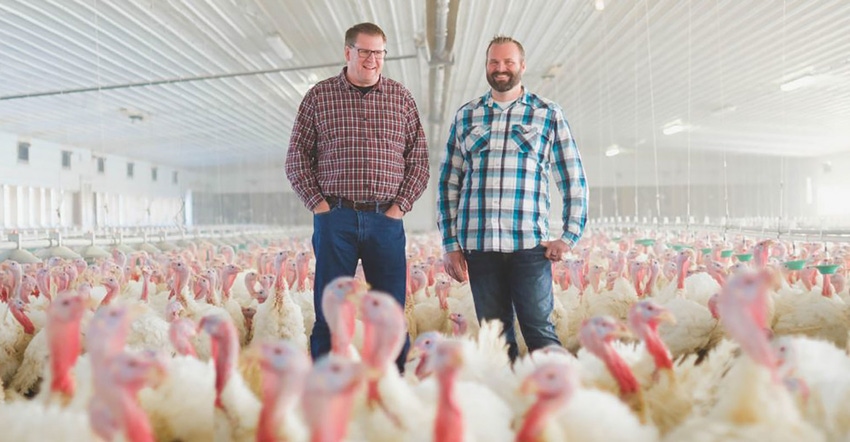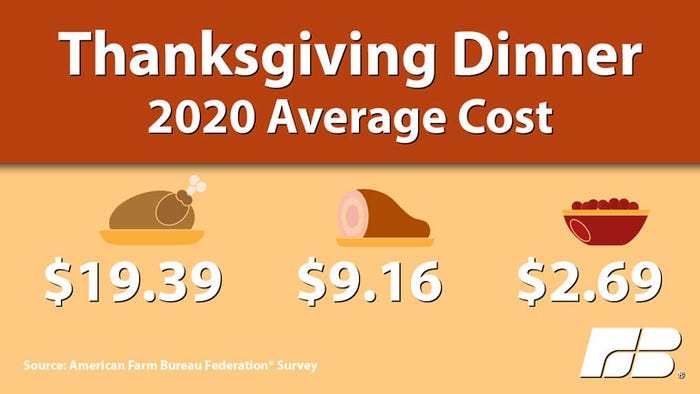November 24, 2020

Turkey, mashed potatoes and pumpkin pie frequently anchor the Thanksgiving dinner table.
While that’s not expected to change, ag experts say the number of Americans eating at the dinner table might because of the COVID-19 pandemic.
According to a recent American Farm Bureau Federation survey, consumers will spend less on the classic Thanksgiving dinner (of about 10 people) by nearly 4%. At $46.90, or less than $5 per person, it’s the lowest average cost for a Thanksgiving dinner since 2010.
“Retailers know this is going to be a special year for our intimate, private gatherings,” says John Newton, AFBF chief economist. “At this point, retailers have not passed the higher ham costs down to their consumers, despite wholesale prices up more than 20%.”

This graphic shows the average national price for a 16-pound whole turkey, a 4-pound ham and 12-ounces of fresh cranberries.
After fielding 230 survey responses, AFBF found turkey costs dipped by about 7% to $19.39 for a 16-pound whole bird. Whipping cream and sweet potato costs also declined from last year at about 16% and 8%, respectively. Elsewhere, the price of a 4-pound ham remained unchanged at $9.16.
AFBF also found buying turkeys from a meal-delivery service will cost a person 64% more at $1.99 per pound, or 42% higher for the overall Thanksgiving dinner.
To find out more about Thanksgiving food prices, visit fb.org.
“I do believe we will have smaller gatherings in light of COVID-19,” says Ernie Birchmeier, manager of the Center for Commodity, Farm and Industry Relations for Michigan Farm Bureau.
Part of the reason is because of the Nov. 15 emergency order from the Michigan Department of Health and Human Services, which limits gatherings to two households at any one time.
“The important thing is there is plenty of food out there,” Birchmeier adds. “It may come in smaller portions, depending on the family size. When folks are out shopping, they are going to have to consider that, whether it’s buying a smaller turkey, a smaller ham or a smaller amount of potatoes or stuffing or cranberries.”
Michigan grown
According to Birchmeier, Michigan farmers produce many Thanksgiving favorites for consumers, including turkey, ham, potatoes, stuffing, butter, cranberries and pumpkins.
Tomac Pumpkins in Saginaw County annually grows 250 different varieties of squash and pumpkins. Sarah Tomac says that about 100 of them are special-eating types that are hard to find or almost lost to history.

Tomac Pumpkins is located near Chesaning in Saginaw County, Mich.
The fourth-generation farmer raises winter squash on 20 of her 200 acres.
“What started as a 4-H project 30 years ago has now grown into the wonderful fall harvest display, offering Indian corn, cornstalks, straw bales, everything fall-related, as well as a small gift shop, which doubles as a small meeting area or classroom outside of the pumpkin season,” says Tomac, noting pumpkins and winter squash are high in vitamins and minerals.
“There are endless ways to eat pumpkin or winter squash. It’s not just limited to pies or baby food,” she adds. “Try stuffing, shredding, dicing, roasting or grilling any flavor. To test for doneness, stick a fork in it. Like potatoes, once the flesh becomes translucent, it is done.”
Michigan turkeys
In Grand Rapids, most Michigan turkeys are processed at Michigan Turkey Producers, a farmer-owned cooperative. Data collected by the trade group Michigan Allied Poultry Industries indicates that the state produces 5.3 million birds each year.
An average turkey weighs 40 pounds and contributes $100 million to the state’s economy.
“Turkey farms in Michigan mainly raise toms, which are bigger than a typical hen raised for a Thanksgiving turkey,” says Allison Brink, executive director of MAPI. “However, one of the main products from a tom is a whole turkey breast, which is perfect for the smaller gatherings happening this year.”
With COVID-19 shifting away some of the business for turkey farmers, Jeff Smith asks consumers for help.
“The pandemic has hit us hard this year with many restaurants closing down or serving less than usual, as a majority of our Michigan turkey usually goes to food service and restaurants,” says Smith, co-owner of Smith’s Turkey Farms in Allegan County. “Michigan turkey farmers would be grateful for your purchase of a Michigan turkey breast for your holiday dinner this year from one of our local partners, such as Costco or Gordon Food Service.”
Source: MFB, which is solely responsible for the information provided and is wholly owned by the source. Informa Business Media and all its subsidiaries are not responsible for any of the content contained in this information asset.
Read more about:
Covid 19You May Also Like




